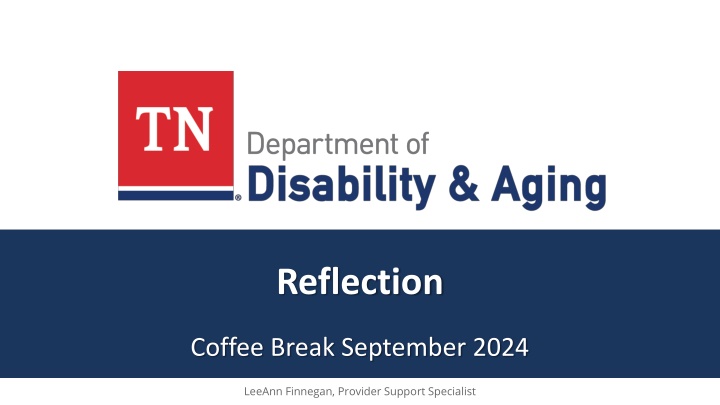
Insights into Reflection and Problem Solving Strategies
Explore the essence of reflection in professional settings, the distinction between problem-solving and reflective practices, and how reflection supports caregivers in enhancing strategies for better outcomes. Discover key indicators and effective reflection questions in coaching for a well-rounded understanding.
Download Presentation

Please find below an Image/Link to download the presentation.
The content on the website is provided AS IS for your information and personal use only. It may not be sold, licensed, or shared on other websites without obtaining consent from the author. If you encounter any issues during the download, it is possible that the publisher has removed the file from their server.
You are allowed to download the files provided on this website for personal or commercial use, subject to the condition that they are used lawfully. All files are the property of their respective owners.
The content on the website is provided AS IS for your information and personal use only. It may not be sold, licensed, or shared on other websites without obtaining consent from the author.
E N D
Presentation Transcript
Reflection Coffee Break September 2024 LeeAnn Finnegan, Provider Support Specialist
Reflection defined Reflection Key Indicators-10, 11, and 12 Using FGBRI reflection principles within supervision Agenda
Difference in Problem Solving and Reflection Problem solving-an exchange of ideas about right now or in the future Example: What is a strategy we can try right now in mealtime, or that you want to try over the next week? Example: What are other routines in which you can offer choices to your child? Reflection-an evaluation of something that has already happened Example: What did you think about offering choices during bathtime? Example: How was offering choices in bathtime different than when you offer choices at mealtime?
Shared Definition-Reflection Questions or comments that are backward facing: How was that? What did you think about that response or that strategy?
Reflection EI supports the caregiver to analyze or evaluate a routine, strategy, or part of the session. Reflection encourages the caregiver to generate ideas to enhance strategy use and ways to generalize strategies to new routines.
Reflection Questions in Coaching Are: Open-ended Come from a sincere desire to learn or inquire Supportive and empathetic in tone Encourage engagement and ownership Can be used to tap inner wisdom Comments or skillful use of "wh" questions Followed by silence to "hold the space" Brown, J. (2020) Collaborative Coaching
Reflection Could be the missing link to caregiver buy-in and implementation. Related to both understanding of and belief in the practice- more than knowing how, it is belief that it matters. Supports motivation and generalization. Engages the learner in self assessment and self efficacy. Should occur throughout the coaching cycle. Is integral to effective problem solving with solutions the caregiver will enact. Brown, J. (2020) Collaborative Coaching
Indicator 11 is: For the parent to define what mastery or next steps look like for their child. As early interventionists, we know what "mastery" of a developmental skill looks like, but... Within the context of a family and home, the parent is the expert on knowing what mastery or realistic next steps to be mastered look like.
Components of Indicator 12 Caregiver takes the lead to identify: Strategies (How) Specific routines, embedding throughout the day (where/who/when) Targets (what) Same components as indicator 4-can tie indicator 12 in one session into indicator 4 in the next session
Three Components Reflection Collaboration Regularity https://www.zerotothree.org/resource/three-building-blocks-of-reflective-supervision/
Reflection Stepping back from the immediate, intense experience of hands-on work to take the time to wonder what the experience really means. Requires a foundation of honesty and trust. Encourages staff to assess their own performance and scaffold current knowledge to build new knowledge and skills.
Collaboration Sharing responsibility and control of power. Allows for dialogue on issues affecting staff and the program as a whole. Additionally, allows for staff to express interest in taking on new tasks, and allow everyone to learn from each other.
Regularity Should take place on a reliable schedule with enough time in between to practice. Reflection and feedback are most effective as immediately as possible after a session. https://www.zerotothree.org/resource/three-building-blocks-of-reflective-supervision/
Resources 15 Ways to Ask Key Indicator 11: https://fgrbi.com/wp- content/uploads/2020/07/15-Ways-KI-11_2020.pdf Brown, J. (2020). Collaborative Coaching in Family- Guided Routines-Based Intervention [Powerpoint slides]. FGRBI Key Indicators Manual: https://fgrbi.com/wp- content/uploads/2021/09/KIManual2021-1.pdf
Resources The SLT Scrapbook http://thesltscrapbook.com Three Building Blocks of Reflective Supervision: https://www.zerotothree.org/resource/three-building- blocks-of-reflective-supervision/
Next Coffee Break: October 24 at 11:30 Central/12:30 Eastern Our next three Coffee Breaks will be a deep dive into the FGRBI EI Competencies (handout available on the Community Resource Website) Please send your questions, comments, and feedback! LeeAnn Finnegan LeeAnn.Finnegan@TN.gov (629) 259-3711






















